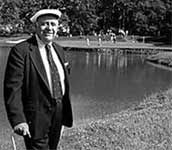 Robert Trent Jones’s emmergence coincided with a change in how courses were built. Before the war, courses were still largely being built by hand, by the machine age was about to begin. Architects would soon utilizing large amounts of earthmoving equipment. Initially, this was done to speed up construction but it soon removed the limits on what could be accomplished. Architects like Jones seized this opportunity and began to move away from adapting their ideas to suit the site, and began a design era of adapting sites to suit their ideas. As harder sites were overcome, this eventually ushered in the idea that anything was possible and golf courses were built on more and more difficult sites – eventually capped off when Jones built Mauna Kea right out of old lava fields by crushing the rock and turning it into soil.
Robert Trent Jones’s emmergence coincided with a change in how courses were built. Before the war, courses were still largely being built by hand, by the machine age was about to begin. Architects would soon utilizing large amounts of earthmoving equipment. Initially, this was done to speed up construction but it soon removed the limits on what could be accomplished. Architects like Jones seized this opportunity and began to move away from adapting their ideas to suit the site, and began a design era of adapting sites to suit their ideas. As harder sites were overcome, this eventually ushered in the idea that anything was possible and golf courses were built on more and more difficult sites – eventually capped off when Jones built Mauna Kea right out of old lava fields by crushing the rock and turning it into soil.
The 1951 US Open made Trent Jones’s famous because of the renovation to Oakland Hills. Trent created what he called target golf by pinching most landing areas on both sides with bunkers and heavily bunkering the greens to create difficulty. Depending on your point of view Jones was either the villain or the hero – but aside from that he was all of a sudden very well known. Trent continued to make use of this new found fame and actively promoted his work as a designed by Robert Trent Jones, and likely even coining the phrase of signature design too. Trent was a far greater salesman, than designer, and quickly became the architect that everybody sought out because he was the best known architect of them all. It could be argued this was the origin of the celebrity designer.

Trent Jones believed in what he called the heroic school of architecture, which was in his mind a blend of the penal school and the strategic school. While his origins point often to Tillinghast and Thompson,Trent Jones also had his own strong ideas including using lots of water right up against greens. He was particularly fond of this idea for par threes where the hole was all carry from tee to green, like the famous 4th at Baltusrol. The idea was one heroic shot would be memorable and using water created heroic situations for the golfer to overcome. The only problem with this was the technique became highly overused by not only Trent, when a hole lacked natural features, but also by everyone else in that period – and is still overused by many architects today.
There were other architects from Eddie Hackett to William Mitchel, but only one gave him any real rivalry and that was Dick Wilson. Wilson was a savvy salesman just like Jones, but lacked the same world wide connections to carry near as much work. His constant battles with alchohol likely kept him from having a far greater presence. His architecture was based upon his old employer William Flynn. It had a little more aesthetic appeal, but was slightly less demanding strategically. He designed Doral shown below among many other well known layouts.

Doral - this week's venue
The interesting thing about the work from this era is how much it has influenced half the golf course architects in practice today, and how much it is completely dismissed by the other group I will talk about at the end of this series.
Next Entry: http://thecaddyshack.blogspot.com/2007/03/1960-1970-emergence-of-pete-dye.html
I think the real issue is, "was it his immergence or his emergence?"
ReplyDeleteIn my view one and all should browse on this.
ReplyDelete